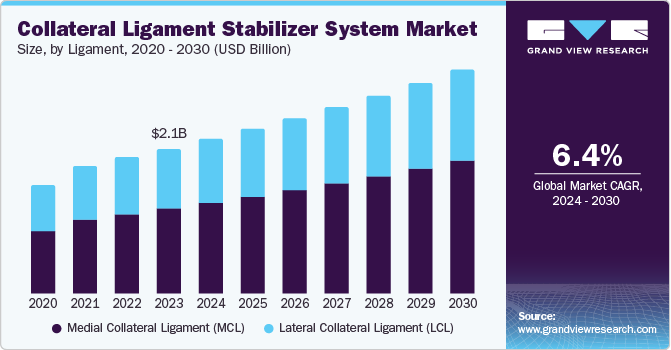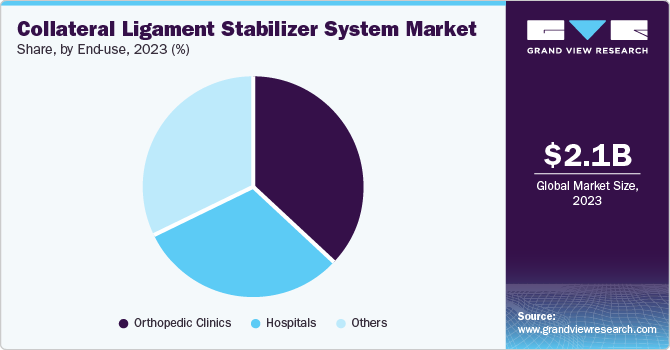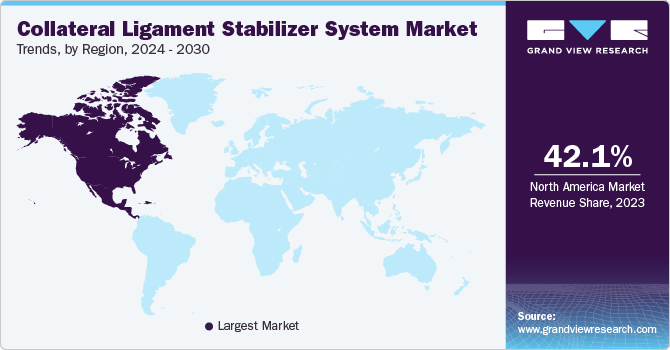- Home
- »
- Medical Devices
- »
-
Collateral Ligament Stabilizer System Market Report, 2030GVR Report cover
![Collateral Ligament Stabilizer System Market Size, Share & Trends Report]()
Collateral Ligament Stabilizer System Market (2024 - 2030) Size, Share & Trends Analysis Report By Ligament, By Injury (Grade I, Grade II, Grade III), By Treatment (Surgical, Non-surgical), By End Use, By Region, And Segment Forecasts
- Report ID: GVR-2-68038-030-9
- Number of Report Pages: 100
- Format: PDF
- Historical Range: 2018 - 2022
- Forecast Period: 2024 - 2030
- Industry: Healthcare
- Report Summary
- Table of Contents
- Segmentation
- Methodology
- Download FREE Sample
-
Download Sample Report
Market Size & Trends
The global collateral ligament stabilizer system market size was valued at USD 2.08 billion in 2023 and is projected to grow at a compound annual growth rate CAGR of 6.4% from 2024 to 2030. The market growth is attributed to the rising prevalence of joint disorders and arthritis, driven by an aging population and increasing sports-related injuries. In addition, technological advancements in collateral ligament stabilizer systems, enabling improved user experience and reduced operational costs, are fueling market expansion. Furthermore, growing healthcare expenditure and patient awareness about the clinical benefits of these devices in developing countries are providing new opportunities for market growth.

The collateral ligament stabilizer system (CLSS) utilizes a specialized collar to exert traction on the ligaments in front of the shoulder joint. Studies have indicated that this system can significantly enhance the recovery outcomes of individuals who have undergone previous shoulder surgery. The collateral ligaments encircle the outer part of the knee, facilitating the connection between the upper and lower leg bones within the knee joint. As robust ropes, these ligaments maintain the knee's stability by linking the bones. The medial collateral ligament connects the femur to the tibia and is positioned on the knee's sides.
The rise in road accidents results in a surge in the need for knee braces and pain management support, boosting the utilization of such products. Enhanced patient education on early detection and consistent monitoring of intraocular pressure (IOP) is anticipated to steer the market in the coming years, aiming to reduce preventable vision impairment. The utilization of collateral ligament stabilizer systems is projected to expand across healthcare facilities with the introduction of favorable reimbursement regulations.
Ligament Insights
The medial collateral ligament dominated the market and accounted for the largest revenue share of 58.7% in 2023. The (Medial Collateral Ligament) MCL is a crucial stabilizer of the knee joint, offering protection against rotational and valgus forces. It is also the most frequently injured ligament in knee trauma. An MCL injury can lead to valgus instability in the knee and increase the risk of developing degenerative knee osteoarthritis. While it has long been believed that non-operative management is the best approach for MCL injuries, it leads the market.
The lateral collateral ligament is expected to grow at a CAGR of 6.0% over projected years, owing to its demand for increasing homecare adoption and emergency medication due to its related advantages and sports. These advantages include better reimbursement policies. Moreover, they also provide instability to the knee, and these stabilizers assist in stable conditions.
Injury Insights
Grade III dominated the market with the largest revenue share of 38.7% in 2023. The grade III ligament tear is a severe tear in which the collateral ligament is completely torn, both deep parts. The patient's knee may be unstable and loose and deal with extreme pain and tenderness. It’s common for someone to have other knee injuries, particularly damage to their anterior cruciate ligament. They are complete ruptures of tendons or muscles & treatment of these injuries can be carried out with a collateral ligament stabilizer system.
Grade II is expected to grow at a CAGR of 6.9% over the forecast years. The patient has a partial tear in the collateral ligament of the knee. When the knee is moved by hand, it feels unstable, and there is likely to be severe pain and bruising on the inner side of the knee. In addition, sports-related activities can cause this type of injury, leading to ligament damage, thereby increasing the segment's growth.
Treatment Insights
The non-surgical treatment segment dominated the market and accounted for the largest revenue share of 57.3% in 2023 owing to the rising prevalence of grade I and II ligament injuries, which can often be managed without surgery. In addition, advancements in non-surgical treatment options, such as bracing, physical therapy, and regenerative therapies, enable better patient outcomes and reduce the need for invasive procedures. Furthermore, the increasing focus on conservative management to avoid complications associated with surgical interventions further propels the demand for non-surgical collateral ligament stabilizer systems.
The surgical treatment segment is expected to grow at a CAGR of 6.6% over the projected years. The exact recovery period from surgery depends upon the tear's severity and other knee injuries. While non-surgical treatment is very effective in treating severe tears, professional athletes may want to consider undergoing surgery to fix their tears due to the amount of stress and pressure they’ll have on their knees when they return to their game. If they have a collateral ligament tear with other knee injuries at the same time, they would have to undertake surgery to fix the injuries.
End Use Insights
Orthopedic clinics dominated the market with a share of 37.3% in 2023. The increasing prevalence of joint disorders drives this growth, and sports-related injuries drive more patients to seek specialized care at orthopedic clinics. In addition, the rising awareness among patients about the benefits of these stabilizers, coupled with the availability of reimbursement coverage in developed regions, is further propelling the demand for these devices in orthopedic clinics. Moreover, the growing number of orthopedic specialists and their focus on providing comprehensive joint care solutions are also contributing to the expansion of this market segment.

Hospitals are expected to grow at a CAGR of 5.8% over the forecast years. The quality infrastructure and presence of fine-quality treatment options with the expertise of healthcare practitioners led to the segment's growth in the upcoming period. In addition, the excellent level of orthopedic specialists offering the best treatment and intense care for patients with rising helps drive the market growth.
Regional Insights
The North America collateral ligament stabilizer system market dominated the global market and accounted for the largest revenue share of 42.1%. This growth is driven by factors such as the high incidence of sports injuries and the increase in collateral ligament injuries with the rise in demand for better treatment for knee injuries. Furthermore, many local and international medical device companies are inclined to invest in this business, urging the adoption of advanced orthopedic devices, which is expected to provide growth opportunities for the market.

U. S. Collateral Ligament Stabilizer System Market Trends
The collateral ligament stabilizer system market in the U.S. dominated the North American market with a revenue share of 89.3%. This growth is attributed to the growing demand for pharmaceuticals, the increasing aging population, and the rising prevalence of timely treatment of joint injuries and other ailments. In addition, developing advanced systems providing enhanced support and comfort for patients is expected to drive market growth.
Asia Pacific Collateral Ligament Stabilizer System Market Trends
The Asia Pacific collateral ligament stabilizer system market is expected to grow at a CAGR of 7.5% over the forecast period. The region has grown in this market and is now in the eye of the global pharma industry, driving betterment, progress, innovation, and development in the healthcare sector. In addition, the market's growth is driven by the increasing prevalence of joint disorders and sports-related injuries, driven by a large population base and growing participation in athletic activities. Furthermore, the rising awareness among patients about the benefits of collateral ligament stabilizers, coupled with the presence of key market players in the region, is further propelling the demand for these devices in the Asia Pacific.
The collateral ligament stabilizer system market in China is expected to grow significantly due to the incidence of chronic disorders such as osteoarthritis and an increase in severe accidents. Furthermore, substantial investment by industry leaders provides potential opportunities for the country's market to grow.
The growth of India collateral ligament stabilizer system market is driven by increased road accidents, which lead to injuries, muscle strains, ligament tears, and ligament trauma. Further technological advancements in equipment have led to the development of more effective and suitable ligament stabilizer systems.
Europe Collateral Ligament Stabilizer System Market Trends
The collateral ligament stabilizer system market in Europe is expected to experience substantial growth owing to the rising prevalence of different joint pains, leading to a growing interest in cutting-edge and superior outcomes. In addition, there is an increase in backbone, knee, elbow, and joint-related disorders among the senior population because weakness in knee ligaments with increasing age is prone to causing severe injuries. The adoption of collateral ligament stabilizer systems is forecasted to rise in healthcare settings due to the implementation of beneficial reimbursement policies.
The UK collateral ligament stabilizer system market is expected to witness substantial growth over the forecast years, driven by improved diagnostic techniques that enable early detection and treatment. This awareness drives the demand for collateral ligament stabilizer systems as part of complete injury management. In addition, the increasing population, expanding healthcare industry, rising incomes, escalating government spending on healthcare, international collaborations, and ongoing innovation are key factors driving the growth of this market in the country.
The collateral ligament stabilizer system market in Germany is anticipated to grow substantially over the projected years. This growth is driven by the country's large population, spending on healthcare, and strong pharmaceutical sector, which conducts continuous research and innovation activities. Moreover, a rise in orthopedic surgeries, with ligament repair and reconstruction, created a greater demand for stabilizer systems used in post-surgical rehabilitation.
Key Collateral Ligament Stabilizer System Company Insights
Some of the key companies in the collateral ligament stabilizer system market include Medical Device Business Services, Inc.; Arthrex, Inc.; Bauerfeind USA Inc.; Ossur; Enovis Corporation; Orthofix Medical, Inc.; Bio Dynamic Technologies; DARCO International, Inc.; DeRoyal Industries, Inc.; and Corin Group. These companies focus on development and gaining a competitive edge in the industry. Therefore, key players are taking several strategic initiatives.
-
Arthrex, Inc. specializes in developing and manufacturing innovative solutions for ligament stabilization. Their products include the Collateral Ligament Reconstruction Set, designed to improve the safety and accuracy of ligament repair and reconstruction procedures around the knee. Arthrex also offers a range of other products, such as the SwiveLock ACL Repair Kit and the Hand/Wrist InternalBrace Ligament Augmentation Convenience Kit, which enhance patient outcomes and facilitate faster rehabilitation.
-
Corin Group manufactures innovative solutions for joint reconstruction and ligament stabilization. Their product portfolio includes the Collateral Ligament Reconstruction System, designed to treat collateral ligament injuries in the knee effectively. The company also offers a wide range of other orthopedic products, such as hip and knee replacement systems, which aim to improve patient outcomes and enhance the quality of life for individuals suffering from joint-related conditions.
Key Collateral Ligament Stabilizer System Companies:
The following are the leading companies in the collateral ligament stabilizer system market. These companies collectively hold the largest market share and dictate industry trends.
- DePuy Synthes
- Arthrex, Inc.
- Bauerfeind USA Inc.
- Ossur
- Enovis Corporation
- Orthofix Medical, Inc.
- Bio Dynamic Technologies
- DARCO International, Inc.
- DeRoyal Industries, Inc.
- Corin Group
Recent Developments
-
In January 2024, Enovis acquired LimaCorporate, an orthopedic implant company. The acquisition is expected to strengthen Enovis' position in the orthopedic reconstruction market. LimaCorporate's portfolio includes advanced 3D-printed Trabecular Titanium implants and a comprehensive shoulder revision offering, further strengthening Enovis' presence in the fast-growing extremities market.
-
In November 2023, Orthofix Medical introduced a new WaveForm L Lateral Lumbar Interbody System in the U.S. This 3D-printed device is launched to be used in lateral lumbar interbody fusion (LLIF) procedures.
Collateral Ligament Stabilizer System Market Report Scope
Report Attribute
Details
Market size value in 2024
USD 2.22 billion
Revenue forecast in 2030
USD 3.21 billion
Growth Rate
CAGR of 6.4% from 2024 to 2030
Base year for estimation
2023
Historical data
2018 - 2022
Forecast period
2024 - 2030
Quantitative units
Revenue in USD Million and CAGR from 2024 to 2030
Report coverage
Revenue forecast, company ranking, competitive landscape, growth factors, and trends
Segments covered
Ligament, injury, treatment, end use, region
Regional scope
North America, Europe, Asia Pacific, Latin America, MEA
Country scope
U.S., Canada, Mexico, UK, Germany, France, Italy, Spain, Denmark, Sweden, Norway, Japan, China, India, Australia, South Korea, Thailand, Brazil, Argentina, South Africa, Saudi Arabia, UAE, Kuwait
Key companies profiled
DePuy Synthes; Arthrex, Inc.; Bauerfeind USA Inc.; Ossur; Enovis Corporation; Orthofix Medical, Inc.; Bio Dynamic Technologies; DARCO International, Inc.; DeRoyal Industries, Inc.; Corin Group.
Customization scope
Free report customization (equivalent to up to 8 analysts' working days) with purchase. Addition or alteration to country, regional & segment scope.
Pricing and purchase options
Avail customized purchase options to meet your exact research needs. Explore purchase options
Global Collateral Ligament Stabilizer System Market Report Segmentation
This report forecasts revenue growth at global, regional, and country levels and provides an analysis of the latest industry trends in each of the sub-segments from 2018 to 2030. For this study, Grand View Research has segmented the global collateral ligament stabilizer system market report based on ligament, injury, treatment, end use, and region.
-
Ligament Outlook (Revenue, USD Million, 2018 - 2030)
-
Medial Collateral Ligament (MCL)
-
Lateral Collateral Ligament (LCL)
-
-
Injury Outlook (Revenue, USD Million, 2018 - 2030)
-
Grade I
-
Grade II
-
Grade III
-
-
Treatment Outlook (Revenue, USD Million, 2018 - 2030)
-
Surgical Treatment
-
Non-Surgical Treatment
-
-
End use Outlook (Revenue, USD Million, 2018 - 2030)
-
Hospitals
-
Orthopedic Clinics
-
Others
-
-
Regional Outlook (Revenue, USD Million, 2018 - 2030)
-
North America
-
U.S.
-
Canada
-
Mexico
-
-
Europe
-
UK
-
Germany
-
France
-
Italy
-
Spain
-
Denmark
-
Sweden
-
Norway
-
-
Asia Pacific
-
Japan
-
China
-
India
-
Australia
-
South Korea
-
Thailand
-
-
Latin America
-
Brazil
-
Argentina
-
-
Middle East and Africa (MEA)
-
South Africa
-
Saudi Arabia
-
UAE
-
Kuwait
-
-
Share this report with your colleague or friend.
Need a Tailored Report?
Customize this report to your needs — add regions, segments, or data points, with 20% free customization.

ISO 9001:2015 & 27001:2022 Certified
We are GDPR and CCPA compliant! Your transaction & personal information is safe and secure. For more details, please read our privacy policy.
Trusted market insights - try a free sample
See how our reports are structured and why industry leaders rely on Grand View Research. Get a free sample or ask us to tailor this report to your needs.










